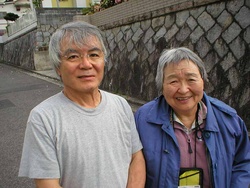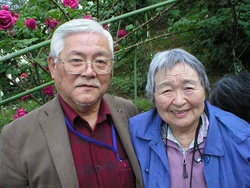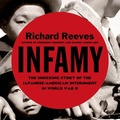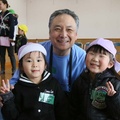August 6, 2009
The Honorable Barack Obama
President of the United States
The White House
1600 Pennsylvania Avenue NW
Washington, D.C. 20500
Dear President Obama,
I am writing to you today, on August 6, 2009, the 64th anniversary of America’s dropping of the first atomic bomb on the city of Hiroshima, in complete support of your mission “to seek the peace and security of a world without nuclear weapons.”

Sansei Soji Kashiwagi stands in front of the Gembaku Dome. He echoes the message heard throughout Hiroshima: “Never again.”
I am a third-generation Japanese American (Sansei), and on that fateful morning 64 years ago members of my Hiroshima family and thousands of others suffered the unthinkable horror of the atomic bomb, while members of my American family sat behind barbed wire unjustly imprisoned in an American concentration camp.
My intention in writing to you is to support and to stand firmly by your efforts so that what happened to my family in Japan and in the United States will never happen again to any family in the world.
In 2006 and in May of this year, I visited the Hiroshima Peace Memorial Museum and Peace Park and walked away with this message from those who were there, and survived the unthinkable horror:
“The only role for nuclear weapons is to be abolished.” And, “No one else should ever suffer as we did.”
Words alone cannot express the utter devastation and human suffering that I saw on display at the Peace Museum. One Japanese photographer tried to capture it on film, but after taking only five photos, he realized what he was witnessing was so shocking, so absolutely horrifying, that he couldn’t take another photo.
Imagine your beloved home cities—Honolulu and Chicago--vaporized in an instant. Imagine ordinary citizens—many of whom were innocent children—killed instantly, or walking through the streets like zombies—bodies burned and disfigured--crying out for help, pleading for water. Imagine hundreds upon hundreds of dead bodies floating down the city’s rivers. Imagine 200,000 people dead. Imagine Hell on earth.
This is what I saw in Hiroshima. This is what happened. Two things, for me, made matters much worse, and truly brought it home: One, that our country, the United States of America, was responsible for this and the nuclear bombing of Nagasaki; and two, that members of my own family were there to suffer through it all. Seeing the devastation is one thing. Knowing that it happened to my own family makes this very personal.

Cousin Katsuzo Ishimaru standing with Sadako Kashiwagi. Katsuzo was two-years-old when the bomb dropped.
My mother’s aunt, Shimeno Ishimaru, and her two sons, Takeshi, then only four years old, and Katsuzo, two, were in their Hiroshima house on August 6, 1945. Luckily, thanks to a ceiling beam falling on top of them, they were able to survive the bombing. But they remember, and while we were in Hiroshima, they told us stories of the immense suffering and horror that was to follow.
Takeshi’s wife, Ikuko, remembered that after the bomb, babies were born without brains. Takeshi remembered as a child using pieces of scrap wood to write his school lessons on, but in searching for that wood, he would uncover bits and pieces of human remains.
I could go on, but I think you’re getting the picture. What I would like to share is what Ikuko and Takeshi said to us near the end of our conversation:
“We need to see one another not by nationalities or by countries but as human beings,” said Ikuko.
Takeshi, when asked how long it took for him to recover from the Atomic Bomb,
said without hesitation, “40 years.” He added that if a nuclear war was to happen, “It would be over. This can’t happen. It can’t.”

Hiroshima Cousin Takeshi Ishimaru standing next to first cousin from California, Sadako Kashiwagi. (Soji’s mother) Takeshi was four-years-old when the atomic bomb destroyed his family's Hiroshima home.
Today, Hiroshima, by all outside appearances, looks to be a thriving city, rebuilt and reborn. However, to use Hiroshima as a shining example of how a city can recover from an atomic bomb attack is misguided and simply untrue. When told of a conservative talk radio host in Los Angeles saying on the air, “Look at Hiroshima, they’ve gotten over the bomb” as if to suggest the use of nuclear weapons is somehow acceptable, both Takeshi and his younger brother, Katsuzo, both reacted in anger and became very emotional.
“This is the kind of attitude that will allow this to happen again,” said Takeshi.
“There is no compassion in this attitude,” said Katsuzo.
Having visited both Hiroshima and Nagasaki, I have concluded that there is absolutely no way to “get over” an atomic bombing. Yes, Hiroshima and Nagasaki have “recovered.” But not far from the surface, the suffering and aftereffects of the atomic bomb continue to this day. Hibakusha, or A-Bomb survivors, currently live in all parts of Japan and around the world, and continue to suffer debilitating aftereffects of radiation poisoning. In our friend’s family, a baby girl born two generations after the bombing is disabled with severe birth defects, due to radiation in her mother, passed onto her from her mother who survived the bomb. And as Takeshi said, it took him 40 years to recover—40 years!
These are the stories most Americans know nothing about. But if we’re going to prevent a nuclear holocaust, these are the stories Americans need to know, and constantly be reminded of so that what happened in Hiroshima and Nagasaki will never happen again to anyone, anywhere,
This need is particularly urgent with North Korea and its recent nuclear testing making headline news. I arrived in Nagasaki on May 25, 2009, the very same day as North Korea’s reckless underground nuclear test which happened to have the same kiloton strength as the bomb that destroyed Nagasaki. Imagine my horror as I sat in my hotel room watching TV in Nagasaki, and seeing the mushroom cloud that destroyed the very same city I was visiting.
As you so eloquently stated in your groundbreaking speech in Prague last April, now more than ever we need to begin talking about and taking steps toward nuclear disarmament—ridding ourselves and the world of nuclear weapons, country by country, one bomb at a time, until there are none. If we don’t take the steps to do this, and a World War III involves the use of nuclear bombs, our world as we know it will be gone forever.

Cenotaph Memorial at Hiroshima Peace Park. Cousin Katsuzo, an artist and master stone sculpter, was part of the team that built this memorial.
My other story involves my American family, born and raised in California, and unjustly imprisoned into remote, desert concentration camps by our government during WWII. As you are well aware, over 120,000 people of Japanese descent, the majority of whom were American citizens, were put away for three to four years without any charges, without due process and with blatant disregard for our Constitution. This was done, said our government, out of “military necessity.”
They believed that Japanese Americans living on the West Coast posed a threat to our security, even though no person of Japanese ancestry was ever charged with espionage. Not one. On the day after Pearl Harbor in 1941, FBI agents conducted raids (without search warrants) of Japanese American homes, ransacked their houses and arrested our first generation immigrant leaders—again, without charges or cause, leaving mothers with young children to fend for themselves, not knowing when they would ever see their husbands again.
I know that you are aware of this dark chapter in American history. You also know that what we are seeing today is eerily similar to what happened to my family and community back then. After 9/11, Americans of Arab, Middle Eastern, and South Asian descent as well as Muslims were attacked and some were killed because they happened to “look” like the enemy. FBI agents once again arrested people who fit the “enemy profile.”
What has happened in our country to our fellow Americans as well as the torture and inhumane treatment of those imprisoned (many taken there without charges brought against them) at Guantanamo Bay and Abu Ghraib is a stark reminder that in the name of “national security” abuses of our Constitution can and are happening once again. And I, as an American of parents and grandparents who suffered through four years of American concentration camps during WWII, am in full support of your efforts to ensure that these abuses are put to an end for good.
Last month, in a New York Times op-ed piece, famed Japanese fashion designer Issey Miyake, who was seven-years-old when the bomb dropped on his hometown of Hiroshima, wrote of his wish for you to visit and walk across the Peace Bridge in Hiroshima city, which he believes “would be both a real and a symbolic step toward creating a world that knows no fear of nuclear threat. Every step taken is another step closer to world peace.”
I share his wish, and hope you can visit Hiroshima, Nagasaki, and of course, Obama, Japan. I know that our friends there will welcome you with open arms, filled with hope for worldwide peace.
My family in the U.S. and Hiroshima thanks you for listening, and for all that you are doing for our country, and our world. Please let me know if I may be of service.
With Warm Aloha,
Soji Kashiwagi
© 2009 Soji Kashiwagi






